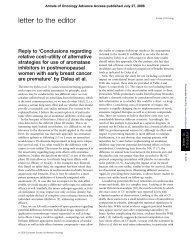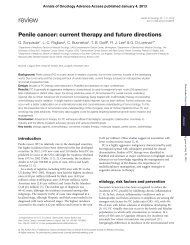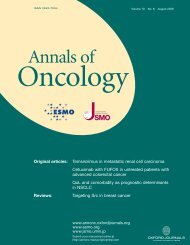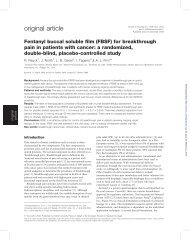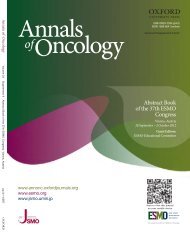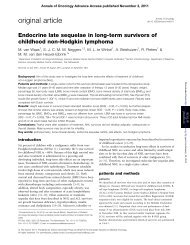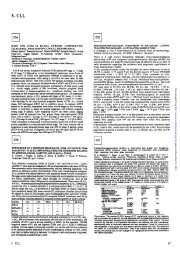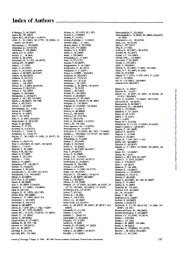A phase I open-label dose-escalation study of oral BIBF 1120 ...
A phase I open-label dose-escalation study of oral BIBF 1120 ...
A phase I open-label dose-escalation study of oral BIBF 1120 ...
Create successful ePaper yourself
Turn your PDF publications into a flip-book with our unique Google optimized e-Paper software.
original<br />
article<br />
original article<br />
Annals <strong>of</strong> Oncology 21: 370–375, 2010<br />
doi:10.1093/annonc/mdp506<br />
Published online 4 November 2009<br />
A <strong>phase</strong> I <strong>open</strong>-<strong>label</strong> <strong>dose</strong>-<strong>escalation</strong> <strong>study</strong> <strong>of</strong> <strong>oral</strong> <strong>BIBF</strong><br />
<strong>1120</strong> combined with standard paclitaxel and carboplatin<br />
in patients with advanced gynecological malignancies<br />
A. du Bois 1 *, J. Huober 2 , P. Stopfer 3 , J. Pfisterer 4 , P. Wimberger 5 , S. Loibl 6 , V. L. Reichardt 3 &<br />
P. Harter 1<br />
1 Department <strong>of</strong> Gynecology and Gynecologic Oncology, Dr. Horst Schmidt Klinik (HSK), Wiesbaden; 2 Department <strong>of</strong> Gynecology and Obstetrics, Tu¨bingen University,<br />
Tu¨bingen; 3 Boehringer Ingelheim Pharma GmbH & Co. KG, Biberach; 4 Department <strong>of</strong> Gynecology and Obstetrics, Kiel University, Kiel; 5 Department <strong>of</strong> Gynecology and<br />
Obstetrics, Essen University, Essen and 6 Department <strong>of</strong> Gynecology and Obstetrics, Johann-Wolfgang-Goethe University, Frankfurt, Germany<br />
Received 24 June 2009; revised 10 September 2009; accepted 25 September 2009<br />
Background: The purpose <strong>of</strong> the <strong>phase</strong> I <strong>dose</strong>-<strong>escalation</strong> <strong>study</strong> was to evaluate the maximum tolerated <strong>dose</strong> (MTD)<br />
<strong>of</strong> <strong>BIBF</strong> <strong>1120</strong>, an <strong>oral</strong> triple angiokinase inhibitor <strong>of</strong> vascular endothelial growth factor, platelet derived growth factor<br />
and fibroblast growth factor receptors, combined with paclitaxel and carboplatin.<br />
Patients and methods: Patients with advanced gynecological malignancies received <strong>BIBF</strong> <strong>1120</strong> twice-daily (b.i.d.)<br />
continuously at 100, 150, 200 or 250 mg, combined with paclitaxel (175 mg/m 2 ) and carboplatin (area under the curve<br />
5 min mg/ml) every 3 weeks. The MTD, safety, pharmacokinetics (PK) and clinical activity were evaluated.<br />
Results: Twenty-two patients were treated. Three experienced <strong>dose</strong>-limiting toxic effects in the first treatment cycle:<br />
1 <strong>of</strong> 13 at 200 mg b.i.d. <strong>BIBF</strong> <strong>1120</strong> [diarrhea, common terminology criteria for adverse events (CTCAE) grade 3]; two <strong>of</strong><br />
two at 250 mg b.i.d. <strong>BIBF</strong> <strong>1120</strong> (elevated alanine aminotransferase and aspartate aminotransferase, CTCAE grade 3/4).<br />
The MTD was defined as 200 mg b.i.d. Principal adverse events were gastrointestinal disorders. No clinically relevant<br />
drug–drug interaction was observed after 20 days treatment with 200 mg b.i.d. <strong>BIBF</strong> <strong>1120</strong> on the PK <strong>of</strong> paclitaxel or<br />
carboplatin and vice versa.<br />
Conclusions: The MTD <strong>of</strong> <strong>BIBF</strong> <strong>1120</strong> in a 20-day continuous dosing regimen with standard-<strong>dose</strong> paclitaxel and<br />
carboplatin was 200 mg b.i.d. This combination had an acceptable safety pr<strong>of</strong>ile and no clinically relevant drug–drug<br />
interactions. Further evaluation <strong>of</strong> this combination is warranted in this indication.<br />
Key words: <strong>BIBF</strong> <strong>1120</strong>, carboplatin, gynecological malignancies, paclitaxel, <strong>phase</strong> I<br />
introduction<br />
Even after optimal treatment, only a minority <strong>of</strong> patients with<br />
stage III or IV ovarian cancer will be alive 5 years after diagnosis<br />
[1]. This high mortality rate has been largely associated with<br />
intrinsic and acquired resistance to currently available cytotoxic<br />
agents. Novel treatment strategies are therefore required.<br />
Angiogenesis is thought to play a central role in the<br />
pathogenesis and clinical behavior <strong>of</strong> ovarian cancer, and<br />
markers <strong>of</strong> increased angiogenesis are correlated with poor<br />
prognosis [2]. The vascular endothelial growth factor (VEGF) is<br />
a key mediator regulating angiogenesis [3, 4] and is expressed in<br />
the majority <strong>of</strong> tumor specimens from patients with ovarian<br />
cancer [5]. Early clinical data with the anti-VEGF agent<br />
bevacizumab have demonstrated that patients with gynecological<br />
cancers can benefit from antiangiogenic compounds [6–8].<br />
*Correspondence to: Dr A. du Bois, Department <strong>of</strong> Gynecology and Gynecologic<br />
Oncology, Dr. Horst Schmidt Klinik (HSK), Ludwig-Erhard-Street 100, D-65199<br />
Wiesbaden, Germany. Tel: +49-611-433-7221; Fax: +49-611-2672;<br />
E-mail: pr<strong>of</strong>.dubois@googlemail.com<br />
<strong>BIBF</strong> <strong>1120</strong> is an <strong>oral</strong>ly available triple angiokinase inhibitor<br />
that simultaneously and potently inhibits vascular endothelial<br />
growth factor receptors, platelet derived growth factor receptors<br />
and fibroblast growth factor receptors [9]. In vivo studies<br />
demonstrated that <strong>BIBF</strong> <strong>1120</strong> significantly inhibits tumor<br />
growth in established xenografts in mice [9]. In a <strong>phase</strong> I<br />
clinical <strong>study</strong> in patients with advanced solid tumors, <strong>BIBF</strong> <strong>1120</strong><br />
had a favorable safety pr<strong>of</strong>ile as twice-daily (b.i.d.) dosing up to<br />
the maximum tolerated <strong>dose</strong> (MTD) <strong>of</strong> 250 mg b.i.d. [10].<br />
The aim <strong>of</strong> this <strong>study</strong> was to determine the MTD <strong>of</strong> <strong>BIBF</strong> <strong>1120</strong><br />
b.i.d. in combination with standard-<strong>dose</strong> paclitaxel and carboplatin<br />
in patients with gynecological cancer. In addition, the safety,<br />
tolerability, clinical activity, pharmacokinetics (PK) and drug–drug<br />
interactions <strong>of</strong> <strong>BIBF</strong> <strong>1120</strong> in this dosing regimen were explored.<br />
patients and methods<br />
ª The Author 2009. Published by Oxford University Press on behalf <strong>of</strong> the European Society for Medical Oncology.<br />
All rights reserved. For permissions, please email: journals.permissions@oxfordjournals.org<br />
<strong>study</strong> population<br />
Patients with a histologically confirmed diagnosis <strong>of</strong> an advanced or<br />
recurrent gynecological malignancy (epithelial ovarian cancer, endometrial<br />
Downloaded from<br />
http://annonc.oxfordjournals.org/ by guest on January 25, 2013
Annals <strong>of</strong> Oncology original article<br />
carcinoma, mixed mesenchymal tumor or cervical carcinoma) with an<br />
indication for paclitaxel and carboplatin combination therapy were eligible<br />
for this trial. Patients were aged ‡18 years with an Eastern Cooperative<br />
Oncology Group [11] performance status <strong>of</strong> zero or one and must have<br />
provided written informed consent. Patients who had received<br />
radiotherapy, chemotherapy, immunotherapy or hormonal therapy within<br />
4 weeks before the start <strong>of</strong> therapy were excluded.<br />
<strong>study</strong> design<br />
This <strong>study</strong> was an <strong>open</strong>-<strong>label</strong> <strong>phase</strong> I trial carried out according to the<br />
Declaration <strong>of</strong> Helsinki and the International Conference on<br />
Harmonization Tripartite Guideline for Good Clinical Practice. It was<br />
approved by the local institutional review board and was conducted in five<br />
centers in Germany from October 2005 to January 2007.<br />
On day 1 <strong>of</strong> each treatment period, patients received a 3-h i.v. infusion <strong>of</strong><br />
paclitaxel (175 mg/m 2 ), immediately followed by a 30-min infusion <strong>of</strong><br />
carboplatin [area under the curve (AUC) 5 min mg/ml]. On days 2–21 <strong>of</strong><br />
each treatment <strong>phase</strong>, patients were administered a b.i.d. <strong>oral</strong> <strong>dose</strong> <strong>of</strong> <strong>BIBF</strong><br />
<strong>1120</strong> (2 · 100 to 2 · 250 mg); patients did not receive <strong>BIBF</strong> <strong>1120</strong> on day 1 to<br />
allow assessment <strong>of</strong> paclitaxel/carboplatin PK parameters before and after<br />
continuous <strong>BIBF</strong> <strong>1120</strong> administration. Therapy was administered for<br />
a maximum <strong>of</strong> six treatment periods. The trial used a 3 + 3 <strong>dose</strong>-<strong>escalation</strong><br />
design [12] in which the <strong>dose</strong>s <strong>of</strong> standard chemotherapy (paclitaxel/<br />
carboplatin) were held fixed and only <strong>BIBF</strong> <strong>1120</strong> was escalated. The following<br />
<strong>dose</strong> levels <strong>of</strong> <strong>BIBF</strong> <strong>1120</strong> were planned: 100, 150, 200 and 250 mg b.i.d. The<br />
MTD was defined as the <strong>dose</strong> at which 7 days; neutr<strong>open</strong>ia CTCAE<br />
grade 3/4 <strong>of</strong> any duration associated with fever >38.3°C; CTCAE grade 4<br />
thrombocyt<strong>open</strong>ia or CTCAE grade 3 thrombocyt<strong>open</strong>ia associated with<br />
bleeding requiring transfusion; inability to resume <strong>BIBF</strong> <strong>1120</strong> dosing within<br />
14 days <strong>of</strong> stopping due to treatment-related toxicity. All DLT events that<br />
occurred after the initial treatment period were classified as significant AEs.<br />
PK sampling<br />
Six milliliter <strong>of</strong> venous blood was collected at prespecified time points for<br />
the determination <strong>of</strong> <strong>BIBF</strong> <strong>1120</strong>, paclitaxel and carboplatin PK pr<strong>of</strong>iles<br />
(supplemental data, available at Annals <strong>of</strong> Oncology online). Analysis was<br />
carried out according to prespecified procedures (supplemental data,<br />
available at Annals <strong>of</strong> Oncology online).<br />
other outcome measures<br />
Efficacy was monitored by objective tumor response, time to tumor<br />
progression and assessment <strong>of</strong> cancer antigen (CA)-125 [14]. RECIST<br />
criteria [15] were used. Patients were assessable for CA-125 response if they<br />
had ovarian carcinoma, one or more pretreatment value >35 U/ml with the<br />
exception <strong>of</strong> one local laboratory with the upper limit <strong>of</strong> normal <strong>of</strong> 65 U/l<br />
and more than two CA-125 values available after first <strong>BIBF</strong> <strong>1120</strong><br />
administration. Patients were deemed responders if, both at any time after<br />
baseline and ‡28 days after baseline, CA-125 decreased by ‡50%, and if at<br />
‡28 days after this first observation <strong>of</strong> CA-125 response, the reduction by<br />
‡50% was maintained.<br />
results<br />
A total <strong>of</strong> 23 patients were enrolled; 22 met eligibility criteria<br />
and were treated with <strong>BIBF</strong> <strong>1120</strong>. Table 1 details the baseline<br />
patient demographic characteristics.<br />
Characteristics <strong>BIBF</strong> <strong>1120</strong> b.i.d. Total<br />
100 mg<br />
150 mg<br />
200 mg<br />
250 mg<br />
(n = 22)<br />
(n = 3)<br />
(n = 4)<br />
(n = 13)<br />
(n = 2)<br />
Age (years)<br />
Median 52.0 63.0 57.0 57.5 58.0<br />
Range<br />
Performance status (ECOG), n (%)<br />
47–64 61–66 32–71 49–66 32–71<br />
0 3 (100) 4 (100) 9 (69) 1 (50) 17 (77)<br />
1 0 (0) 0 (0) 3 (23) 1 (50) 4 (18)<br />
2<br />
Type <strong>of</strong> cancer, n (%)<br />
0 (0) 0 (0) 1 (8) 0 (0) 1 (5)<br />
Epithelial ovarian cancer 2 (67) 4 (100) 8 (62) 1 (50) 15 (68)<br />
Endometrial cancer 0 (0) 0 (0) 2 (15) 0 (0) 2 (9)<br />
Uterine sarcoma 0 (0) 0 (0) 2 (15) 0 (0) 2 (9)<br />
Cervical cancer<br />
Number <strong>of</strong> prior chemotherapies, n (%)<br />
1 (33) 0 (0) 1 (8) 1 (50) 3 (14)<br />
None 2 (67) 3 (75) 9 (69) 0 (0) 14 (64)<br />
One 1 (33) 0 (0) 3 (23) 2 (100) 6 (27)<br />
Two 0 (0) 0 (0) 0 (0) 0 (0) 0 (0)<br />
Three or more 0 (0) 1 (25) 1 (8) 0 (0) 2 (9)<br />
Previous radiotherapy, n (%) 0 (0) 0 (0) 4 (31) 1 (50) 5 (23)<br />
ECOG, Eastern Cooperative Oncology Group.<br />
Volume 21 | No. 2 | February 2010 doi:10.1093/annonc/mdp506 | 371<br />
Downloaded from<br />
http://annonc.oxfordjournals.org/ by guest on January 25, 2013
original article<br />
MTD determination, safety and tolerability<br />
According to initial <strong>dose</strong> <strong>of</strong> <strong>BIBF</strong> <strong>1120</strong>, the number <strong>of</strong> patients<br />
analyzed was as follows: 100 mg <strong>BIBF</strong> <strong>1120</strong> b.i.d., n = 3; 150 mg<br />
<strong>BIBF</strong> <strong>1120</strong> b.i.d., n = 4; 200 mg <strong>BIBF</strong> <strong>1120</strong> b.i.d., n = 13 and 250<br />
mg <strong>BIBF</strong> <strong>1120</strong> b.i.d., n = 2. The median total duration <strong>of</strong><br />
exposure to <strong>BIBF</strong> <strong>1120</strong> for all patients was 243.0 days (range<br />
33–330 days). No <strong>dose</strong> reduction <strong>of</strong> paclitaxel or carboplatin<br />
due to continuous administration <strong>of</strong> <strong>BIBF</strong> <strong>1120</strong> was necessary.<br />
One exception was a patient with advanced uterine sarcoma,<br />
who was first changed to carboplatin AUC 4 min mg/ml in the<br />
second cycle due to thrombocyt<strong>open</strong>ia and then to weekly<br />
paclitaxel administration without carboplatin after starting<br />
treatment cycle 4 due to thrombocyt<strong>open</strong>ia. <strong>BIBF</strong> <strong>1120</strong> was<br />
continued. One patient was given cisplatin instead <strong>of</strong><br />
carboplatin following an allergic reaction to the latter.<br />
During the first treatment period, three patients experienced<br />
DLTs: both patients from the 250-mg <strong>dose</strong> cohort reported<br />
elevated aspartate aminotransferase (AST; CTCAE grade 3,<br />
n = 1; CTCAE grade 4, n = 1) and alanine aminotransferase<br />
(ALT; both CTCAE grade 3) levels; one patient from the 200mg<br />
<strong>dose</strong> cohort experienced diarrhea (CTCAE grade 3). Hence,<br />
the MTD for b.i.d. dosing <strong>of</strong> <strong>BIBF</strong> <strong>1120</strong> in combination with<br />
paclitaxel and carboplatin was defined as 200 mg <strong>BIBF</strong> <strong>1120</strong><br />
b.i.d.; a total <strong>of</strong> 13 patients were evaluated at the MTD.<br />
Sixteen <strong>of</strong> 22 patients received all six planned cycles <strong>of</strong><br />
combination therapy and went on to receive <strong>BIBF</strong> <strong>1120</strong><br />
monotherapy. Six patients discontinued combination therapy<br />
earlier, most frequently due to AEs (n = 5), with one patient<br />
withdrawing consent.<br />
Over the entire <strong>study</strong>, including both combination and<br />
monotherapy <strong>phase</strong>s, nine patients reported DLTs. In addition<br />
to the three patients who experienced DLTs in treatment period<br />
1 as outlined above, there were four reports <strong>of</strong> DLTs in<br />
treatment period 2 (increased AST and ALT, n = 1; neutr<strong>open</strong>ia,<br />
n = 1; thrombocyt<strong>open</strong>ia, n = 2). There was one reported DLT<br />
in treatment period 3 (febrile neutr<strong>open</strong>ia) and one in treatment<br />
period 8 during <strong>BIBF</strong> <strong>1120</strong> monotherapy (increased ALT).<br />
Serious adverse events (SAEs), all requiring hospitalization,<br />
were reported for seven (32%) patients over the entire <strong>study</strong>.<br />
Treatment-related SAEs occurred exclusively in the 200-mg <strong>BIBF</strong><br />
<strong>1120</strong> b.i.d. <strong>dose</strong> cohort and were as follows: diarrhea and<br />
concomitant vomiting (n = 1); diarrhea and thrombocyt<strong>open</strong>ia<br />
(n = 1) and leuc<strong>open</strong>ia, neutr<strong>open</strong>ia, lung infiltration and<br />
pyrexia (n = 1). SAEs not related to drug treatment were as<br />
follows: ascites and dyspnea (n = 1), subileus (n = 1), fluid in<br />
uterus and hydrometra (n = 1) and breast cancer (n = 1). Nine<br />
patients (41%) discontinued treatment due to AEs, including one<br />
patient during the first course <strong>of</strong> treatment. This patient had<br />
grade 3 diarrhea which was not treated according to the<br />
recommendations <strong>of</strong> the protocol. Those that were considered to<br />
be <strong>BIBF</strong> <strong>1120</strong> related, as judged by the investigator, were serious<br />
diarrhea and concomitant serious vomiting (n = 1), diarrhea<br />
(n = 2) and thrombocyt<strong>open</strong>ia (n = 2). The other reasons were<br />
depression (n = 1) in a patient with history <strong>of</strong> depression, disease<br />
progression (n = 1) and subileus (n = 1). In addition, one<br />
patient had increased CA-125 levels, indicating disease<br />
progression. This was reported as an AE and resulted in<br />
discontinuation. There were no deaths reported during the <strong>study</strong>.<br />
The most frequently reported AEs over the entire <strong>study</strong> were<br />
gastrointestinal disorders (n = 22, 100%), mostly <strong>of</strong> grade 1<br />
and 2. The most common AEs were alopecia (91%), diarrhea<br />
(86%), fatigue (64%), myalgia (55%), nausea (59%) and<br />
vomiting (55%). All other individual AEs were reported by less<br />
than one-third <strong>of</strong> all patients. The incidence <strong>of</strong> drug-related<br />
AEs, by highest CTCAE grade, occurring in the MTD cohort<br />
(200 mg <strong>BIBF</strong> <strong>1120</strong> b.i.d.) and in the 250-mg <strong>BIBF</strong> <strong>1120</strong> b.i.d.<br />
<strong>dose</strong> cohort, over the entire <strong>study</strong> is summarized in Table 2.<br />
The incidence and pattern <strong>of</strong> AEs reported during the<br />
combination therapy <strong>phase</strong> was similar to the cumulative<br />
incidence and pattern <strong>of</strong> AEs for the entire <strong>study</strong>. The AE pr<strong>of</strong>ile<br />
during the monotherapy <strong>phase</strong> differed from the AE pr<strong>of</strong>ile<br />
Table 2. Drug-related adverse events, by highest CTCAE grade,<br />
occurring in ‡10% or ‡grade 3, in patients treated at the MTD <strong>dose</strong><br />
cohort (200 mg <strong>BIBF</strong> <strong>1120</strong> b.i.d.; n = 13) and at the 250-mg b.i.d. <strong>dose</strong><br />
cohort (n = 2)<br />
Adverse events Grade 1,<br />
n<br />
Grade 2,<br />
n<br />
Annals <strong>of</strong> Oncology<br />
Grade 3,<br />
n<br />
Nausea 8 2<br />
Vomiting 5 3<br />
Diarrhea 8 3 4<br />
Abdominal pain/dyspepsia 6<br />
Fatigue 3 5 1<br />
Anorexia 3<br />
Hypokalemia 3<br />
Pyrexia 2 2<br />
Infection 1<br />
Nasopharyngitis 6<br />
Urinary tract infection 2 2<br />
Hydrometra 1<br />
Ascites/disease progression a<br />
1<br />
Myalgia 4 4<br />
Arthralgia 3<br />
Back pain/pain in extremity 2 2<br />
Headache 4<br />
Peripheral sensory neuropathy 3 4<br />
Cough 2<br />
Dyspnea 5<br />
Alopecia 13<br />
Erythema/rash 4<br />
Nail disorder 2<br />
Hot flush 2<br />
Anemia 3<br />
Leukocyt<strong>open</strong>ia 2 1<br />
Neutr<strong>open</strong>ia 1 2<br />
Thrombocyt<strong>open</strong>ia 2 2<br />
ALT 4<br />
AST 2 1<br />
GGT 2<br />
Grade 4,<br />
n<br />
Adverse events <strong>of</strong> all courses are shown.<br />
a<br />
A single case <strong>of</strong> grade 3 ascites was reported to be potentially drug related<br />
in a patient with advanced ovarian cancer.<br />
CTCAE, common terminology criteria for adverse events; MTD, maximum<br />
tolerated <strong>dose</strong>; ALT, alanine aminotransferase; AST, aspartate<br />
aminotransferase; GGT, gamma-glutamyl transpeptidase.<br />
372 | du Bois et al. Volume 21 | No. 2 | February 2010<br />
Downloaded from<br />
http://annonc.oxfordjournals.org/ by guest on January 25, 2013
Annals <strong>of</strong> Oncology original article<br />
during the entire <strong>study</strong>; the incidence <strong>of</strong> gastrointestinal<br />
disorders was lower (56%) than during the entire <strong>study</strong> and the<br />
incidences <strong>of</strong> skin and s.c. tissue disorder and musculoskeletal<br />
and connective tissue disorders were markedly decreased<br />
compared with combination therapy, mainly due to the absence<br />
<strong>of</strong> any cases <strong>of</strong> alopecia or myalgia on <strong>BIBF</strong> <strong>1120</strong> monotherapy.<br />
With the exception <strong>of</strong> liver enzymes, there were no clinically<br />
meaningful differences between <strong>dose</strong> groups with respect to<br />
median change from baseline in safety laboratory parameters.<br />
There were incidences <strong>of</strong> elevated AST, ALT and GGT,<br />
particularly in the 250-mg <strong>BIBF</strong> <strong>1120</strong> b.i.d. <strong>dose</strong> cohort, in<br />
which two patients had CTCAE grade 3 or 4 elevations <strong>of</strong> AST<br />
and/or ALT values during treatment period 1 that qualified as<br />
DLT events. These, and indeed all deteriorations in safety<br />
laboratory parameters, were reversible. During the entire <strong>study</strong>,<br />
one incidence <strong>of</strong> hypertension (grade 2) occurred in the 200mg<br />
b.i.d. <strong>dose</strong> tier.<br />
pharmacokinetics<br />
The PK parameters <strong>of</strong> paclitaxel and carboplatin are shown in<br />
Table 3 and in supplemental data (available at Annals <strong>of</strong><br />
Oncology online). There were no clinically relevant drug–drug<br />
interactions <strong>of</strong> 20-day continuous administration <strong>of</strong> 200 mg<br />
<strong>BIBF</strong> <strong>1120</strong> b.i.d. on the PK <strong>of</strong> paclitaxel or carboplatin.<br />
The drug plasma concentration–time pr<strong>of</strong>iles <strong>of</strong> <strong>BIBF</strong> <strong>1120</strong><br />
after multiple <strong>oral</strong> administrations <strong>of</strong> 200 mg <strong>BIBF</strong> <strong>1120</strong> b.i.d.<br />
are shown in supplemental data (available at Annals <strong>of</strong> Oncology<br />
online). Following administration, maximum plasma<br />
concentrations were mainly reached 1–4 h after <strong>dose</strong>. The<br />
steady state for <strong>BIBF</strong> <strong>1120</strong> was reached, at the latest, after 7 days<br />
<strong>of</strong> <strong>BIBF</strong> <strong>1120</strong> b.i.d. dosing. There was no deviation from a <strong>dose</strong>proportional<br />
PK <strong>of</strong> <strong>BIBF</strong> <strong>1120</strong> (data not shown). During the<br />
repeated dosing period <strong>of</strong> <strong>BIBF</strong> <strong>1120</strong> in combination with<br />
carboplatin and paclitaxel, there were no systematic increases or<br />
decreases in <strong>BIBF</strong> <strong>1120</strong> plasma concentrations.<br />
<strong>dose</strong> reduction<br />
One patient receiving 250 mg <strong>BIBF</strong> <strong>1120</strong> b.i.d. had her <strong>dose</strong><br />
reduced to 200 mg b.i.d. and one had her <strong>dose</strong> reduced first to<br />
200 mg b.i.d. and then to 150 mg b.i.d.; both had increased<br />
levels <strong>of</strong> AST/ALT <strong>of</strong> CTCAE grade 3 or 4. Two patients in the<br />
200-mg b.i.d. cohort had their <strong>dose</strong> reduced to 150 mg b.i.d.<br />
due to AST/ALT elevation (n = 1) and repeated episodes <strong>of</strong><br />
diarrhea (n = 1), and one patient in the 200-mg b.i.d. cohort<br />
had her <strong>dose</strong> reduced to 100 mg.<br />
clinical activity<br />
Seven patients were assessable for tumor response according to<br />
RECIST. One ovarian cancer patient (in the 200-mg b.i.d.<br />
cohort) had a complete response (CR), four patients (two in<br />
the 150-mg b.i.d. cohort, both with ovarian cancer, and two in<br />
the 200-mg b.i.d. cohort) had a partial response (PR) and two<br />
patients (in the 200-mg b.i.d. cohort) had stable disease (SD) as<br />
their best response to therapy. Ten ovarian cancer patients were<br />
assessable for CA-125 levels (five patients in first-line treatment<br />
and five patients in second- or later-line treatment): all were<br />
classed as responders. Five patients had progressive disease<br />
during the <strong>study</strong>; progression-free survival (PFS) in these<br />
patients ranged from 177 to 282 days.<br />
discussion<br />
The MTD <strong>of</strong> <strong>BIBF</strong> <strong>1120</strong> in this combination regimen was<br />
determined to be 200 mg b.i.d., which is comparable to that<br />
observed in another <strong>phase</strong> I trial <strong>of</strong> <strong>BIBF</strong> <strong>1120</strong> combined with<br />
Table 3. Comparison <strong>of</strong> pharmacokinetic parameters <strong>of</strong> paclitaxel and carboplatin on the day <strong>of</strong> infusion before <strong>BIBF</strong> <strong>1120</strong> dosing (day 1 <strong>of</strong> treatment<br />
period 1) and after continuous administration <strong>of</strong> <strong>BIBF</strong> <strong>1120</strong> for 20 days (day 1 <strong>of</strong> treatment period 2) for patients treated with 200 mg <strong>BIBF</strong> <strong>1120</strong> b.i.d<br />
MTD Treatment period 1<br />
(n = 13)<br />
Treatment period 2 [n = 13<br />
(paclitaxel); n = 12 (carboplatin)]<br />
n = 11<br />
gMean gCV (%) gMean gCV (%) gMean ratio<br />
(TP2/TP1)<br />
Paclitaxel<br />
C max (ng/ml) 3370 45.5 4180 63.4 119.35 81.68–174.40<br />
AUC0–N (ng h/ml) 10 900 39.2 13 900 42.4 125.33 90.98–172.66<br />
t max a (h) 3.0 2.8–4.0 3.2 2.9–5.3<br />
t ½ (h) 12.8 14.0 12.2 11.8<br />
CL (l/h/m 2 ) 16.0 39.6 12.5 43.0<br />
Carboplatin<br />
C max (ng/ml) 16 600 19.0 16 400 19.6 92.99 83.16–103.98<br />
AUC0–N (ng h/ml) 118 000 24.0 149 000 32.0 123.12 103.95–145.81<br />
tmax a (h) 0.85 0.5–1.3 1.2 0.67–1.5<br />
t ½ (h) 55.3 20.8 67.3 61.8<br />
CL (l/h) 5.0 30.1 4.0 45.2<br />
a Median and range.<br />
MTD, maximum tolerated <strong>dose</strong>; gMean, geometric mean; gCV, geometric coefficient <strong>of</strong> variation; CI, confidence interval; Cmax, maximum measured<br />
concentration <strong>of</strong> the analyte in plasma; AUC 0–N, area under the concentration–time curve <strong>of</strong> the analyte in plasma over the time interval from zero<br />
extrapolated to infinity; tmax, time from (last) dosing to the maximum measured concentration <strong>of</strong> the analyte in plasma; t1/2, terminal half-life <strong>of</strong> the analyte<br />
in plasma; CL, total clearance <strong>of</strong> analyte in plasma following intravascular administration.<br />
90% CI<br />
Volume 21 | No. 2 | February 2010 doi:10.1093/annonc/mdp506 | 373<br />
Downloaded from<br />
http://annonc.oxfordjournals.org/<br />
by guest on January 25, 2013
original article<br />
carboplatin and paclitaxel in patients with non-small-cell lung<br />
cancer [16]. No <strong>dose</strong> reduction <strong>of</strong> paclitaxel or carboplatin due<br />
to continuous administration <strong>of</strong> <strong>BIBF</strong> <strong>1120</strong> was necessary.<br />
The combination <strong>of</strong> <strong>BIBF</strong> <strong>1120</strong> b.i.d. with paclitaxel and<br />
carboplatin had an acceptable safety pr<strong>of</strong>ile. The majority <strong>of</strong><br />
AEs were <strong>of</strong> CTCAE grade 1 or 2 and the most frequently<br />
reported AEs were gastrointestinal disorders, primarily<br />
diarrhea, nausea and vomiting. This AE pr<strong>of</strong>ile is consistent<br />
with those observed with other angiogenesis inhibitors [17–20].<br />
In contrast to other angiogenesis inhibitors, however [17–19],<br />
we did not observe any significant incidence <strong>of</strong> hypertension in<br />
this <strong>study</strong>. Five patients reported grade 3 ALT elevations, two<br />
patients had grade 3 AST elevations and there was one<br />
incidence <strong>of</strong> grade 4 AST elevation. All these elevations were<br />
found in the higher <strong>dose</strong> groups <strong>of</strong> <strong>BIBF</strong> <strong>1120</strong> (200 and 250 mg<br />
b.i.d.) but resolved during the <strong>study</strong> and were reversible.<br />
A 20-day continuous administration <strong>of</strong> <strong>BIBF</strong> <strong>1120</strong> in<br />
combination with paclitaxel and carboplatin showed objective<br />
antitumor activity in this mixed group <strong>of</strong> gynecological<br />
patients. According to RECIST, one patient had a CR, four<br />
patients had a PR and two patients had an SD as their best<br />
overall response. All ten patients that were assessable for CA-<br />
125 response were responders, and 9 <strong>of</strong> 10 remained so until<br />
the end <strong>of</strong> the trial.<br />
The addition <strong>of</strong> 200 mg b.i.d. <strong>BIBF</strong> <strong>1120</strong> appeared to have no<br />
clinically significant effect on the PK parameters <strong>of</strong> paclitaxel or<br />
carboplatin. When comparing geometric mean (gMean) AUC 0–N<br />
and C max values <strong>of</strong> paclitaxel before and after <strong>BIBF</strong> <strong>1120</strong><br />
treatment, an increase <strong>of</strong> 20%–25% was seen. This increase was<br />
not considered clinically relevant as no systematic increases<br />
were seen in either <strong>of</strong> the parameters between treatment<br />
periods. With respect to carboplatin, after <strong>BIBF</strong> <strong>1120</strong><br />
administration, gMean C max values were bioequivalent,<br />
although a 25% increase in gMean AUC 0–N was observed.<br />
Again, due to the apparent lack <strong>of</strong> systematic increase between<br />
treatment periods, this was deemed to be clinically irrelevant.<br />
Although this <strong>study</strong> was not sized formally to determine drug–<br />
drug interactions, the gMean ratios and 90% confidence<br />
intervals <strong>of</strong> AUC 0-N and C max between treatment period 1<br />
(absence <strong>of</strong> <strong>BIBF</strong> <strong>1120</strong>) and treatment period 2 (presence <strong>of</strong><br />
<strong>BIBF</strong> <strong>1120</strong>) for each drug do not fall entirely within or out <strong>of</strong><br />
the 0.8–1.25 range for bioequivalence. However, given the high<br />
background exposure variability <strong>of</strong> these drugs [21–23], these<br />
data indicate that if any interaction (undetectable as statistically<br />
significant) <strong>of</strong> <strong>BIBF</strong> <strong>1120</strong> treatment on the PK <strong>of</strong> a single <strong>dose</strong><br />
<strong>of</strong> 175 mg/m 2 paclitaxel or on a single <strong>dose</strong> <strong>of</strong> AUC 5 min mg/<br />
ml carboplatin were to exist, it is unlikely to be clinically<br />
significant.<br />
The single-<strong>dose</strong> and steady-state PK parameters that were<br />
observed in this <strong>study</strong> <strong>of</strong> <strong>BIBF</strong> <strong>1120</strong>, administered in<br />
combination with paclitaxel and carboplatin, are comparable to<br />
those seen with single-agent dosing [24]. This indicates that<br />
there were no unfavorable drug–drug interactions <strong>of</strong> paclitaxel<br />
and carboplatin on the PK <strong>of</strong> <strong>BIBF</strong> <strong>1120</strong>.<br />
In conclusion, the MTD <strong>of</strong> <strong>BIBF</strong> <strong>1120</strong> was 200 mg b.i.d. in<br />
a 20-day continuous dosing regimen with standard-<strong>dose</strong><br />
paclitaxel (175 mg/m 2 ) and carboplatin (AUC 5 min mg/ml) in<br />
patients with advanced gynecological malignancies. This<br />
treatment regimen was seen to have an acceptable safety pr<strong>of</strong>ile,<br />
consisting primarily <strong>of</strong> gastrointestinal disorders. There was no<br />
effect <strong>of</strong> any clinically relevant drug–drug interaction <strong>of</strong> <strong>BIBF</strong><br />
<strong>1120</strong>, on the PK <strong>of</strong> either carboplatin or paclitaxel, and neither<br />
drug appreciably altered the PK <strong>of</strong> <strong>BIBF</strong> <strong>1120</strong>. The addition <strong>of</strong><br />
the novel triple angiokinase inhibitor <strong>BIBF</strong> <strong>1120</strong> does not<br />
impair the application <strong>of</strong> standard paclitaxel/carboplatin, is<br />
tolerable and <strong>of</strong>fers an <strong>oral</strong>ly available new mode <strong>of</strong> antitumor<br />
treatment. More advanced <strong>phase</strong> studies <strong>of</strong> <strong>BIBF</strong> <strong>1120</strong> in<br />
patients with gynecological malignancies are warranted. The<br />
Arbeitsgemeinschaft Gynaekologische Onkologie<br />
Studiengruppe (AGO <strong>study</strong> group) is currently planning<br />
a randomized evaluation <strong>of</strong> <strong>BIBF</strong> <strong>1120</strong> concomitant with<br />
platinum–paclitaxel and as maintenance therapy in first-line<br />
treatment <strong>of</strong> advanced ovarian cancer.<br />
funding<br />
Boehringer Ingelheim (minor < $10 000) to J.P.<br />
acknowledgements<br />
The authors thank G. Elser and team from the AGO <strong>study</strong><br />
<strong>of</strong>fice and P. Schantl and team from Schantl Monitoring.<br />
disclosure<br />
AdB and JH act as consultants for Boehringer Ingelheim<br />
(minor
Annals <strong>of</strong> Oncology original article<br />
11. Oken MM, Creech RH, Tormey DC et al. Toxicity and response criteria <strong>of</strong> the<br />
Eastern Cooperative Oncology Group. Am J Clin Oncol 1982; 5: 649–655.<br />
12. Simon R, Freidlin B, Rubinstein L et al. Accelerated titration designs for <strong>phase</strong> I<br />
clinical trials in oncology. J Natl Cancer Inst 1997; 89: 1138–1147.<br />
13. Trotti A, Colevas AD, Setser A et al. CTCAE v3.0: development <strong>of</strong><br />
a comprehensive grading system for the adverse effects <strong>of</strong> cancer treatment.<br />
Semin Radiat Oncol 2003; 13: 176–181.<br />
14. Rustin GJ, Bast RC Jr., Kell<strong>of</strong>f GJ et al. Use <strong>of</strong> CA-125 in clinical trial evaluation<br />
<strong>of</strong> new therapeutic drugs for ovarian cancer. Clin Cancer Res 2004; 10:<br />
3919–3926.<br />
15. Therasse P, Arbuck SG, Eisenhauer EA et al. New guidelines to evaluate<br />
theresponsetotreatmentinsolidtumors.EuropeanOrganizationfor<br />
Research and Treatment <strong>of</strong> Cancer, National Cancer Institute <strong>of</strong> the United<br />
States, National Cancer Institute <strong>of</strong> Canada. J Natl Cancer Inst 2000; 92:<br />
205–216.<br />
16. Camidge DR, Conkling P, Stephenson J et al. Pharmacokinetic (PK) analysis<br />
<strong>of</strong> a <strong>phase</strong> I <strong>study</strong> <strong>of</strong> continuous <strong>oral</strong> treatment with the angiokinase inhibitor<br />
<strong>BIBF</strong> <strong>1120</strong>, in combination with carboplatin and paclitaxel in patients with<br />
advanced non-small cell lung cancer (NSCLC). J Clin Oncol 2008; 26: (Abstr<br />
3567).<br />
17. Cobleigh MA, Langmuir VK, Sledge GW et al. A <strong>phase</strong> I/II <strong>dose</strong>-<strong>escalation</strong> trial <strong>of</strong><br />
bevacizumab in previously treated metastatic breast cancer. Semin Oncol 2003;<br />
30: 117–124.<br />
18. Ratain MJ, Eisen T, Stadler WM et al. Phase II placebo-controlled randomized<br />
discontinuation trial <strong>of</strong> sorafenib in patients with metastatic renal cell carcinoma.<br />
J Clin Oncol 2006; 24: 2505–2512.<br />
19. Rock EP, Goodman V, Jiang JX et al. Food and Drug Administration drug<br />
approval summary: sunitinib malate for the treatment <strong>of</strong> gastrointestinal<br />
stromal tumor and advanced renal cell carcinoma. Oncologist 2007; 12:<br />
107–113.<br />
20. Strumberg D, Richly H, Hilger RA et al. Phase I clinical and pharmacokinetic<br />
<strong>study</strong> <strong>of</strong> the Novel Raf kinase and vascular endothelial growth factor receptor<br />
inhibitor BAY 43-9006 in patients with advanced refractory solid tumors. J Clin<br />
Oncol 2005; 23: 965–972.<br />
21. Duffull SB, Robinson BA. Clinical pharmacokinetics and <strong>dose</strong> optimisation <strong>of</strong><br />
carboplatin. Clin Pharmacokinet 1997; 33: 161–183.<br />
22. Gianni L, Kearns CM, Giani A et al. Nonlinear pharmacokinetics and metabolism<br />
<strong>of</strong> paclitaxel and its pharmacokinetic/pharmacodynamic relationships in humans.<br />
J Clin Oncol 1995; 13: 180–190.<br />
23. Sonnichsen DS, Relling MV. Clinical pharmacokinetics <strong>of</strong> paclitaxel. Clin<br />
Pharmacokinet 1994; 27: 256–269.<br />
24. Stopfer P, Roth W, Mross KB et al. Pharmacokinetic characterization <strong>of</strong> <strong>BIBF</strong><br />
<strong>1120</strong>, an <strong>oral</strong>ly active triple angiokinase inhibitor (VEGFR, PDGFR, FGFR) in<br />
advanced cancer patients. In AACR-NCI-EORTC International Conference on<br />
Molecular Targets and Cancer Therapeutics Edition (Poster 73). Prague, Czech<br />
Republic 2006.<br />
Volume 21 | No. 2 | February 2010 doi:10.1093/annonc/mdp506 | 375<br />
Downloaded from<br />
http://annonc.oxfordjournals.org/ by guest on January 25, 2013



